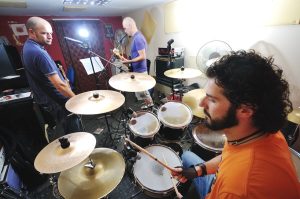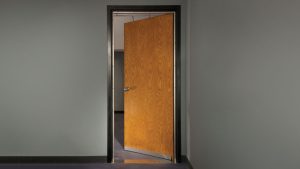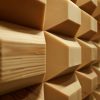Reducing the noise from indoor golf simulators
Golf is one of the most popular sports worldwide. It gets us out into nature, we get our steps in, and eighteen holes are a great, active way to kill an afternoon.
Many of us spend the summers squeezing in as many rounds as we can before the snow flies. But, that limited time isn’t enough for all of us. For that reason, indoor golf simulators have grown exponentially in popularity over the past few years.
If you share your living space with others or are particularly close to your neighbors, golf simulator noise reduction will keep your relationships healthy and intact.
The constant noise from your practice game can wear even the thickest skin thin. There are ways to soundproof your simulator and your room that will make the rest of them think you’ve fallen out of practice.
Golf Simulator Noise Reduction Basics
It’s pretty easy to see why the noise caused by an indoor golf simulator would be an annoyance to some of your family and friends.
Even the golfer isn’t immune to the mental effects that come along with an abundance of annoying sounds.
If you want to minimize those nuisances for all around you, it’s time to think about creating a more soundproof golf simulator.
Identify the source of the sound
The first step in tackling any noise issue is identifying where the bulk of the noise comes from. In this case, the club striking the ball and the ball striking the screen are going to be your primary sources of sound waves.
The whack of the ball may not sound terribly loud when you’re on the course, but enclosed in an indoor space, reverberation can amplify it to annoying levels.
Mix that with a group of competitive guys razzing each other, and your simulator is suddenly producing more sound than you would have imagined. Now, what to do about it.
Negating the Noise
Since the source of the sound is pretty straightforward, determining how far the sound travels is going to be the main consideration when putting together your soundproof room plan. Is the sound simply drifting into the next room? Is it reaching the neighbor’s house? The more noise you’re dealing with, the more acoustic treatments will help. Striking the right balance of acoustic products in the room will lower noise levels to an acceptable spot.
Treating the walls
One of the most important parts of soundproofing any room is making sure your walls are up to par. If your simulator is in a basement or surrounded by thick, concrete walls, noise from golf simulators will rarely reach the neighbors. The thickness and density of the walls should soak up the sounds. If it’s in a basement, anything that makes it through the walls is likely to be absorbed by the surrounding earth. It’s an ideal situation, but not always easy to make a reality.
If your simulator is on a higher level of the house, you will most likely be dealing with standard studs and drywall. You’re absolutely going to want to utilize some golf simulator noise reduction steps in this case.
Increasing the density
Many people add a second layer of drywall. This added layer gives the wall increased density, covers the cracks between sheets, and minimizes the amount of sound passage through the wall.
Adding green glue between the layers of drywall gives you the maximum amount of sound reduction that you can get from your double drywall barrier. It’s an easy thing to do yourself if you’re somewhat handy, so you can save money on labor and achieve great results by going this route.
Not all of us are handy, and there are solid options for those of us who aren’t. The easiest way to add acoustic treatments to your walls may be to add acoustic panels.
The sound created when your club strikes the ball isn’t too bass-heavy or droning, so adding some decorative panels to the walls may be just the thing you need.
Acoustic panels for golf simulator
Acoustic panels are typically constructed of a frame that’s filled with some sort of sound-absorbing material, and the whole thing is wrapped with decorative fabric. They give your wall extra density right where you need it.
You can custom print your panels or choose from a number of very cool prints and patterns. Acoustic panels for golf simulator rooms are a fabulous mix of form and function, and you’ll love what they do to keep the people you share your world with happy.
Treating the Windows
If the room has windows, they are always an excellent place to focus your attention when it comes to audio leakage. Older, single-pane windows probably won’t cut it. They don’t provide much thickness, and the frames might be leaking sound. And if they leak sound, chances are they leak air. Shoring up your windows will pull double duty by keeping sound and drafts at bay.
If you’re in the market for new windows, double-paned or soundproof windows are great choices.
If you can’t swing a full replacement right now, or you want to keep your historical windows accurate, you can purchase window inserts that deliver many of the benefits new windows deliver.
They fit over your existing windows but create an added glass layer with new seals at a fraction of the money and time investments that go along with new window installation. Let some natural light in without letting the sound out.
Soundproofing the Simulator
Sometimes it’s easier to soundproof the simulator than the entire room. If your simulator is situated in a large room, soundproofing the simulator rather than the room may bring down your soundproofing cost and create separate areas within the space. Now that you know a little about how to soundproof a room let’s translate that newfound knowledge to the simulator itself.
Stop the sound at its source
The noise sources in a golf simulator are relatively easy to address since they are very predictable. Specifically, noise is created when you strike the ball with your club and when the ball strikes the wall or screen.
While you can’t do away with either of these completely, you can minimize the amount of sound energy released when these impacts occur. There are a few ways to do this.
You can choose softer balls for your simulator, which cuts down on some of the noise created at each point of impact. The problem with going this route is that some people feel it affects their game and don’t really go for it.
If you’re mainly practicing your form when using the simulator, it isn’t going to be much of an issue. Your form stays the same, even if the feel of the impact is a little off. On the other hand, if you play with competitive friends, you may want another option. That involves deadening the impact on the screen or wall.
If you play with a screen, try lightening the tension a bit. Allowing your screen more slack will soften the blow, which will soften the sound—a pretty easy fix. However, if you play on a wall, you’ll need to add a layer to bring that sound down.
Installing golf sim wall padding on the wall’s surface will protect the wall and keep impact noise to a minimum. You can install it directly on top of your drywall so that most people can do it themselves. The improved wall texture will also give your room a more professional feel, so your acoustic treatments are less distracting and more a point of pride.
Golf Simulator Side Protection
One of the most effective ways of soundproofing your simulator room may be to stop the sound waves before they ever reach the walls. Installing golf simulator side panels does just that.
Your new golf simulator panels will keep the sounds down and help prevent damage from any biffed shots or ricocheted balls. Using them in conjunction with more traditional methods of soundproofing provides superior results.
Golf Simulator Ceiling Protection
Solid soundproofing is a 360˚ operation, and as such, the ceiling needs to be addressed as well as the walls. Treating the ceiling helps keep reverberation down, and if your simulator is in the basement, it will allow your family to watch movies upstairs without you whacking distractions through the floor at them.
Placing panels or golf simulator baffles above the unit achieves the same golf simulator noise reduction that wall-mounted panels do. An advantage of ceiling-mounted panels is that they can be mounted directly to the ceiling joists or suspended below them.
Not only do they keep the sound from the simulator down, but they also help absorb some of the sounds created by HVAC systems or people walking above you.
Consult an Expert
Sometimes we need a little help to get things just right. Even though you now know more about how to make a room soundproof, golf simulator noise reduction can be tricky for those new to the acoustical arena.
If you’re unsure what solutions will work best for you, where to place your acoustic panels, or have any other questions about your project, don’t hesitate to consult with an expert.
Acoustical professionals can ensure your soundproofing is effective and not just a handful of acoustical products hanging on the walls.

















Add comment
You must be logged in to post a comment.